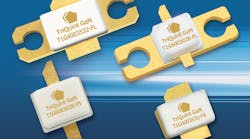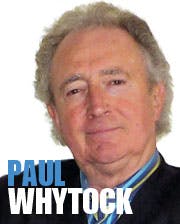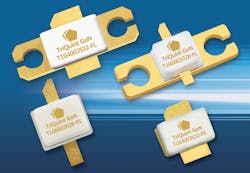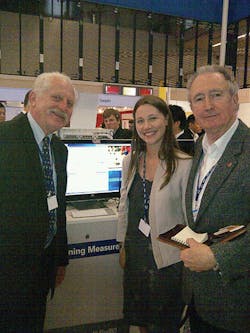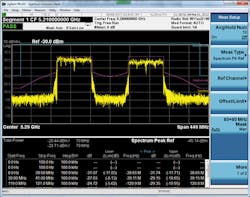Staged in Amsterdam, the “Venice” of northern Europe, European Microwave Week 2012 (EuMW) is a small show occupying just one section of the RAI Congress Centre. Yet the show’s small size belied the amount of activity at this key industry event. Every fall, numerous microwave and RF companies choose the event as the launchpad for their new products and technologies. Though there are no prizes for the most new technology announcements, such an award would be hotly contested within an annual industry event that featured new products ranging from components and devices—from gallium-nitride (GaN) products to the latest in test and measurement instruments.
Over the past couple of years, the emergence of GaN-based products at EuMW has steadily escalated. This trend is not surprising, considering GaN’s well-recognized advantages compared to other high-frequency device technologies. Among those advantages are high breakdown voltage, wide bandgap, high thermal conductivity [when used with silicon-carbide (SiC) substrates], and high current density. Yet the high cost of GaN technology has always been a concern. While this may have been true during the early years of GaN products, newer GaN-based products are benefitting from significant cost reductions, thanks to the development of CMOS-compatible GaN-on-silicon processes.
Mark Andrews, TriQuint Semiconductor’s Strategic Marketing Communications Manager, Infrastructure & Defense Products, agrees that GaN prices are falling. He attributes some of that reduction to less expensive manufacturing processes, but also to economy of scale relative to the number of new products being developed. Among the dozen new offerings introduced by TriQuint Semiconductor were new GaN transistors. According to the company, those transistors exhibit product specifications that will allow RF designers to cut the space devoted to RF signal amplification by as much as 50% (Fig. 1).
1. These new GaN transistors promise to enable RF designers to cut the space devoted to RF signal amplification by as much as 50%.
Also being shown at the TriQuint booth was a device dubbed the “Diplexer” module. It combines multiple filter functions inside a 5-x-5-mm module. “This is quick-time custom manufacturing, so the customer calls up the factory, picks the filters they want in the module, and we turn these out as if it was a standard product,” explains Andrews. TriQuint also unveiled four packaged gallium-arsenide (GaAs) pHEMT RF power-amplifier (PA) modules and several new base-station products for Long Term Evolution (LTE) and related fourth-generation (4G) cellular communications technologies at the show.
Analog Devices used EuMW to introduce a new family of microwave integrated circuits (ICs)—the ADF55xx series voltage-controlled oscillators (VCOs). They target point-to-point (PtP) communications, instrumentation/test equipment, and satellite-communication (satcom) applications. Featuring very good phase-noise performance, the new ADF55xx VCO series covers 3.5 to 13.9 GHz with a broad frequency-tuning range. With reference-design evaluation boards available comprising the phase-locked loop (PLL), active loop filter, power management, and microwave VCO, the new family complements ADI’s PLL-synthesizer portfolio.
Base Stations Inspire New Designs
Amsterdam also was the venue chosen by AMCAD Engineering to announce an upgrade of its pulsed-current-voltage (PIV) semiconductor-device measurement system for the next generation of high-voltage fast-switching (HVFS) transistors. Those transistors promise to enable new designs for high-efficiency DC-DC converters, switches, hubs and servers, base stations, and automotive applications. New HVFS transistor technology, such as enhanced-mode GaN FET and silicon-carbide (SiC) MOSFET devices, offers switching frequencies that can be up to 10 times higher than previous solutions. As a result, electronic designers can use these new devices at lower duty cycles. Previously, no efficient testing solutions existed to characterize these new devices, which can provide simultaneously high-voltage signals and short-pulse/fast-switching capabilities.
Base stations also are the focus of two 5-V in-phase/quadrature (I/Q) devices from NXP Semiconductor. They combine high dynamic range with fast on/off switching performance for use in digitally modulated RF transmitters. The BGX7100 and BGX7101 devices operate between 400 MHz and 4 GHz. Because RF performance is independent of input common-mode voltage, these modulators offer flexible interfacing with any digital-to-analog converter (DAC), simplifying design-in while lowering material costs.
The main difference between NXP’s two I/Q modulators is output power: 0 dBm for model BGX7100HN and +4 dBm for model BGX7101HN, providing solutions for infrastructure cell sizes from small to macrocells. Along with high dynamic range and low noise floor, the devices boast monotonic output third-order intercept behavior versus frequency. They also stand out for their performance in the lowest unadjusted carrier feed through (-50 dBm feedthrough at -7 dBm output power at 1960 MHz) and in the highest unadjusted sideband suppression in the market (-45 dBc at -7 dBm output power at 1960 MHz).
With fast on/off switching, the BGX710x series modulators can shift from power-saving mode to full-performance and stable operation within 1 ms—even for the most demanding time-division-duplex (TDD) systems. This results in power-consumption savings of more than 50%, claims NXP.
Test Equipment Makes Its Presence Known
At the 2012 EuMW, National Instruments launched its PXIe-5667 spectrum-monitoring receiver (Fig. 2). This receiver, available in 3.6- and 7.0-GHz versions, was designed for over-the-air RF measurements. It is based on the PXIe-5665 vector signal analyzer (VSA). Matthew Friedman, NI’s Senior Product Manager for Automated Test, explained that the PXIe-5667 allows users to perform real-time signal analysis—such as continuous spectrum monitoring, spectrogram, and advanced signal processing—when coupled with NI FlexRIO and the NI LabVIEW field-programmable-gate-array (FPGA) module.
2. Dr. James Truchard (“Dr. T”), National Instruments’ Co-Founder and CEO, discusses the finer points of the company’s PXIe-5667 with Microwaves & RF’s Sally Ward-Foxton and Paul Whytock at European Microwave Week 2012.
These signal-processing functions can be performed in the FPGA without the latency of moving data to and from the host controller or personal computer (PC). Available LabVIEW FPGA intellectual property (IP) for the receiver includes digital-down-converter channelization, frequency-hop detection, and the ability to uncover spectrum-mask violations. The PXIe-5667 features a dynamic range beyond 110 dB and distortion performance with a third-order-intercept (TOI) point of greater than +17 dBm. It covers 20 Hz to 7 GHz with as much as 50 MHz real-time bandwidth and scan rates to 30 GHz/s.
Also on display was new software from Agilent Technologies for its X-Series signal analyzers, which expands wireless-local-area-networking (WLAN) support to include the emerging IEEE 802.11ac standard. In fact, one-button IEEE 802.11ac testing is now included in the N9077A WLAN measurement application with a new option, 4FP. When combined with the PXA signal analyzer (the high-end model in the X-Series), for example, option 4FP enables measurement of the full bandwidth of IEEE 802.11ac signals for bandwidths from 20 to 160 MHz and 80+80 MHz (Fig. 3). Agilent also showed off extended frequency options for its lower-cost member of the X-Series, the CXA signal analyzer. Options now include 13.6 and 26.5 GHz.
3. The N9077A-4FP option for the PXA, MXA, and EXA signal analyzers supports the noncontiguous channel SEM of 80+80 MHz in IEEE 802.11ac.
Of course, those were not the only new test and measurement equipment announcements gracing the floor of this year’s EuMW. Other test companies showing their microwave wares included Anritsu, with new capabilities for its ME7838A vector-network-analyzer (VNA) test system. For example, that system now includes four-port test solutions and 500-GHz extensions. Anritsu also demonstrated the 125-GHz noise-figure measurement capability of the MS4640A VNA.
Meanwhile, Rohde & Schwarz debuted a new microwave signal and spectrum analyzer, the FSW43. While it’s designed for applications to 43.5 GHz, external harmonic mixers can extend the analyzer’s frequency range to 110 GHz. External mixers take advantage of the analyzer’s high second intermediate frequency (IF) of 1.3 GHz, providing an image-free range of 2.6 GHz for wideband signals. The instrument can perform spectral measurements including on WLAN signals in the 60-GHz band and IEEE 802.11ad signals.
With the preamplifier switched on, this analyzer’s average noise level is just -164 dBm. With a phase noise of -117 dBc/Hz offset 10 kHz from a 40-GHz carrier, the FSW43 allows high-sensitivity measurements even close to the carrier, making it suitable for measuring radar signals. With its broad analysis bandwidth to 160 MHz, the analyzer can measure the wideband, hopping, and chirp signals occurring in aerospace and defense (Ka-band) and automotive (E-band) radar applications.
